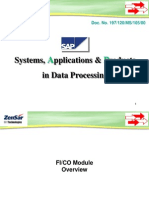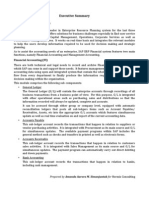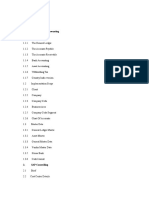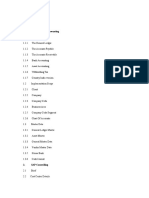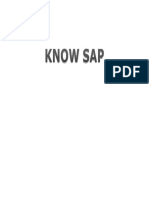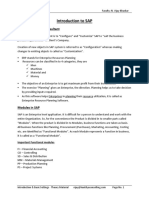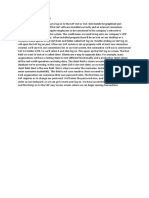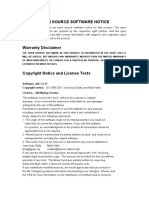SAP Financial Accounting (FI)
- [Instructor] SAP ERP is broken up into different modules that interact with each other. Let's dive
into the SAP financial accounting module, often referred to as SAP FI. The SAP FI module is
responsible for tracking and reporting on financial data across an organization. It contains nearly
every financial business process a company may have. Because it is so versatile, the SAP FI module
is one of the most widely implemented by companies using SAP. In SAP FI, all our transactions start
and end with a general ledger or G/L. The G/L includes all a company's financial transaction data
and a chart of accounts where all the accounts are listed in the system. Transactions are recorded
in sub modules that can be reconciled with the general ledger data in real time. There are four
primary sub modules of SAP FI in the general ledger. They are accounts payable, accounts
receivable, asset accounting and bank management. Accounts payable, or AP is the sub module
that houses supplier related data. This is where we can look at a business partner record for a
supplier and see information like current payment terms. Capabilities of accounts payable include
invoice and credit memo posting, invoice payments, and automatic payments programs. It's also
where supplier reporting happens. Let's look at an example. In our test system, we're looking at a
document of an outgoing payment for 15,000 U.S. dollars. We can see our vendor is called ABC
Insurance. We can also see the general ledger accounts. Next, we have accounts receivable or AR.
This is where we deal with business partner records to manage our customer data. Transactions
and accounts receivable include invoice creation, invoice posting and payments, and it's where we
run any customer base reporting we may need. Again, let's jump into our system and this time we'll
look at an accounts receivable document. Here we're looking at an invoice that was created from a
sales order in the system. We can see that this invoice is for a payer named Midwest Supply
Company. The net value of this invoice is 480 U.S. dollars. And in the line-item area below, we have
the specific line-by-line details for this invoice. We can see it that this invoice was for consulting
services executive, and the customer was billed for four hours. The SAP FI sub module that deals
with the company's fixed assets is called asset accounting. Examples of fixed assets are things like
owned warehouses, land, vehicles, and computer hardware or software. Functions of asset
accounting include recording acquisition, depreciation, sales, and the retirement of these fixed
assets. Let's look at an asset master record. Back in our test system, we're looking at the asset
master data for a 2019 Mercedes Sprinter. We see that the asset class for the Sprinter is vehicles.
We could drill down and look at the value of this asset, including things like depreciation by pressing
the asset values button in the bottom right. The final major sub module of the general ledger is bank
accounting. It deals with all of the company's bank account transactions. It's used to reconcile all
transactions recorded on bank statements and compare them with the transactions in the system
to ensure that they balance. Let's look at a bank master record. Our test system is now displaying a
bank master record for Chase Manhattan Bank. It includes the bank key and the Swift number. A
major benefit of the way the SAP FI system is designed is that all of the sub modules are integrated,
and transactions are updated in real time. This means that accurate financial statements can be
pulled from the system at a moment's notice.
�SAP Controlling (CO)
- [Instructor] Let's look at the SAP controlling module, called SAP CO. SAP controlling deals with
planning and monitoring business operation costs. It has powerful reporting functions and can
show exactly where money is being spent at a company. Ideally, this can be used to increase
profitability. The five primary sub modules of the SAP CO module are profit center accounting, cost
center accounting, internal orders, product costing and profitability analysis. Profit center
accounting is used to evaluate profit or loss of independent areas within a company. Instead of
looking at a company's profitability. Let's look at a profit center in SAP. In our test system, we're now
looking at profit center 1011. This profit center is called widget sales. We can also see this profit
centers controlling area, which is controlling area 1000. In the validity date, we can see this profit
center became valid on January one, 2017, and there is no end date for this profit center. Next, we'll
look at cost centers. They deal with the costs associated with a company's internal departments,
like sales or human resources. Cost centers deal only with expenses, not revenues. They show
exactly how much departments are spending. Let's look at a cost center. Back in our test system,
we're looking at a cost center 100105. And this cost center is called accounting. We can see that the
cost of their category is marked as W. This means it's an administration cost center. Internal orders
are used to manage the costs for small internal projects within a controlling area. Internal orders
are used for in-depth analysis of short-term projects or a one-time expense, such as a trade show.
Internal orders are different from cost centers. As they're able to collect both costs and revenue. In
our SAP test system, we're viewing master data for an internal order for a Las Vegas trade show. We
can see the order number at the top. We can also see the order type is Y400. This is the code for
internal order marketing. Product costing looks at the costs required to produce goods and
services. It gives clarity to manufacturing costs and it helps with decisions on whether it's worth
buying a product to resell or better to manufacture it in-house. Let's look at an example. In our test
system, we're looking at material cost estimate for material called blue widgets size two. We can see
the value of $187.50 for each one piece of blue widget size two manufactured. Finally, profitability
analysis measures the profitability of the products or services offered. And it helps us make pricing
decisions. A key feature is the ability to determine profitability by geographic region or country,
distribution channels or how profitable sales to a single customer R.
�SAP Sales and Distribution (SD)
- [Instructor] The SAP sales and distribution module or SAP SD is the backbone of the selling and the
transportation of products and services. SAP SD is a logistics module that is used to deal with
customer and product related data. Organizations use this data to manage all of the sales,
ordering, shipping, billing and invoicing of their goods and services. SD is best visualized when
broken into the sales cycle. First, our pre-sales actions where inquiries and quotations are created.
Next is sales where sales orders or more robust sales arrangements, like contracts and scheduling
agreements are created. Third is distribution. This is where delivery documents are created. And
goods are picked from the warehouse, packed and then shipped to the customer. Last is billing and
returns, where billing documents and invoices are created. And if necessary, any return orders are
also created. Let's look at a typical sales and distribution process in the system. First, we're going to
look at a quotation from our pre-sales step in our test system. This quote is for a customer called
Seattle Retailers. The total amount of this quote is 2,500 U.S. dollars. When we look below in our
item list, we see that this quote is for a potential order of 50 small steel plates. Moving on to an
example from our sales phase, we are now looking at a sales order in our test system. Sales orders
are very similar to quotations. We can actually create sales orders with reference to the quotations
that are already in the system. This will bring over a bunch of information like the sold to and
shipped to parties, ao we don't need to reenter that information. In our example sales order, we
again see our customer is Seattle Retailers and our net value is 2,500 U.S. dollars. However, when we
look below and our item overview, we see that this order is for 50 large steel plates. After sales
orders are finalized, our shipping documents are then created. Now, we're looking at an outbound
delivery document. Here, we can see the dates for the products for this order were loaded from the
warehouse and delivery date in time of 11 o'clock of March 16th, 2018 to our customer. So we've
looked at our sales quotes, the sales order and our outbound delivery document. The final step in
the process is billing. Now we're looking at an invoice. Here, we can see our net value of 360 U.S.
dollars, the payer, which is Georgia Distribution and the billing date of March 13, 2018. We've had a
look at the general sales and distribution process in SAP. Each of these steps in the SAP SD module
generate transactions in the other modules in SAP. Let's review two common examples of this
integration. First, when a sales order is generated, the system does a product availability check in
the materials management module to make sure there is actually stock to be sold. At the same
time, SAP also runs a credit check for a customer in the finance module to ensure this customer will
be reliable about paying their invoices. The sales and distribution process is highly dependent on
other modules. This tight integration enables efficient selling and transportation of products and
services at a company.
�SAP Materials Management (MM)
- [Instructor] The next module we'll look at is materials management or MM. This is a logistics
module that many other modules rely on to keep the supply chain functioning. Materials
management ensures that there are always the required materials in stock. The key benefits of
materials management are the way it can help increase productivity and reduce costs by handling
materials efficiently. The four major components of materials management in SAP are material
master data, purchasing, inventory management and physical inventory. First, we'll look at master
data in materials management. One component of MM master data are material master records.
They include a huge amount of information about a specific material. Next, our business partner
records for suppliers. These records document all the physical and financial information pertaining
to the suppliers a company is working with. Finally, we've got purchasing information records. These
act as the marriage between material information and supplier information. For example, a
supplier's current price of a particular material is stored in the purchasing information record. Let's
look at a material master record in the system. This is the basic data one screen of a material master
for material TTS five. In our description field, we can see that this material is a small titanium screw.
Our record also shows the base unit of measure. In this case, our small titanium screws are sold by
piece. When we scroll down, we see the dimensions area that shows that the net weight of each
screw is 35 grams. Across the top, where it says basic data one, basic data two, purchasing, et
cetera. Each of these are tabs that has many fields that allow for input. These tabs have over 200
available fields. There are a few required fields, but a material master can be as detailed as a
company needs. The next MM module component we'll explore is purchasing. This includes
procurement activities, like purchase requisitions and purchase orders. Let's look at a purchase
order in our system. We're now looking at a standard purchase order and we're in our delivery slash
invoice tab. We can see the vendor number and name. This purchase order is for Indiana Supply
Company. And the date the order was created was March one, 2019. The grid below shows line
items of what was ordered. It looks to be a raw material named RM20 and 500 pieces were ordered
at a price of $1.23 per piece. Inventory management and the MM module does exactly what it says.
It manages the inventory. Examples here include goods receipts from suppliers and internal
transfers, where we move a material from one storage area to another. Let's look at an inventory
management report in the system. This is an important inventory management report that showing
all the goods receipts at a particular plant. In the first column, we have which material was received.
In the second column, we have our plant, which is 17, 10. In the third column, we have our storage
location within that plant. The last three columns show us when the material was received, how big
the order was and in what unit of measure. Was it in pieces or each-es? Closely tied to inventory
management, we've got physical inventory. This is where physical inventory is documented. Various
inventory strategies can be implemented. For example, a company may choose periodic inventory
where they count all inventory at a specified time. Alternatively, a company may go with a process,
like cycle counts. A cycle count is where a small sample of inventory in one storage location is
counted at a specific time. Let's look at a physical inventory report in our test system. This is a
report showing our physical inventory for a specific material called small widgets. At plant 1710 in
storage location 171A, we can see that our current stock 4,998 pieces was last counted on June 11,
2019. The last column shows that our inventory counts still needs to be executed for our current
period. When used effectively, the materials management module is a powerful tool to ensure an
efficient supply chain.
�SAP Production Planning (PP)
- [Instructor] Let's look at the SAP Production Planning module, often abbreviated as SAP PP. This
module is used to help plan the manufacturing for sales and distribution of products. SAP PP has
the ability to handle businesses that have both repetitive manufacturing models where the
manufactured products stay the same over a long period of time and discreet production models.
Businesses using discrete production models tend to use order based production where the product
is customized or change frequently. Four of the major aspects of SAP production planning are: the
bill of materials, routings, capacity planning, and materials requirement planning. Let's take a look
first at the bill of materials. The bill of materials is often referred to as the BOM in SAP. It is a
complete list of the materials, assemblies, and other components needed to manufacture a
product. Essentially, a bill of materials is the ingredients list part of a recipe. Let's take a look at a
BOM in the system. This is a bill of materials for a metal picture frame. We see that there are three
line items in our material grid below. This means there are three components to make up our metal
picture frame. Each of these components has a different quantity needed to make up the product.
Our first line item shows that we need four pieces. The second, eight pieces, and the third row we
see we need 32 pieces. Routings are up next. They are description of which operations and in which
sequence these operations need to occur for something to be produced. Routings are used for
scheduling the production of semi-finished and finished products. They are also used to help
calculate the operation cost for a finished product. We talked about the bill of materials acting like
the ingredients list of a recipe. In our example the routings act as the step-by-step instructions of the
same recipe. In this case to make a product. Let's look at a routing in SAP. We'll look at the same
product as in the bill of materials. Our metal picture frame. This is a simple routing where there's
only one operation and it's called assembly. This routing tells a lot of information. We have a base
quantity of 100 pieces and it's going to take 30 minutes to set up the machine, and 10 minutes of
labor to complete the assembly operation. Next up is capacity planning. Capacity planning is done to
balance the production load across different work areas which called work centers in SAP. Over in
our test system, we're looking at a report that displays that capacity evaluation of the assembly work
center at plant 1710 over a specified date range. For each weekday date, we can see that there is a
480 minutes of available capacity. If we look at our last column, which is remaining available
capacity, we can see that all of our capacity is remaining. This means we can start booking
production to this assembly work center right now. Materials requirement planning called MRP is
used to ensure every material we need is available for production. The key feature of MRP is that
when it is run, it will create procurement proposals. It ensures production can happen to meet our
demand and it minimizes the cost of holding too much unnecessary inventory. Let's look at MRP in
the system. Back in our test system we're looking at an MRP list for our metal picture frame. It
shows us that we have an available quantity of zero in our stock, but we have a quantity of six of this
material in storage location 171D that is sitting there because of a production order from July 12th,
2018. The production planning module enables businesses to efficiently produce the goods needed
to meet customer demand.
�SAP Quality Management (QM)
- [Instructor] Let's explore the SAP Quality Management module, also known as SAP QM. As the
name indicates, this module deals with managing quality throughout a company's processes. There
are three major areas of the Quality Management module. They are quality inspection, quality
control, and quality notifications. Let's take a look at each of these areas. Quality inspection helps
determine if the units inspected meet defined quality requirements. This is where inspection lots,
results recording, and defect recording all take place. Let's take a look at an inspection lot in our SAP
system. This is an inspection lot for a goods receipt. That means we're inspecting goods that were
ordered from an external vendor. This inspection lot had a quantity of 10. Of these 10, zero units
were defective or destroyed. Quality control is the area where different preventive, monitoring, and
corrective activities take place. This is also where suppliers can be evaluated on quality. If a
supplier's products are consistently not meeting a company's quality standards, it shows that it
would be worthwhile seeking out a better supplier. Let's look at an inspection plan in the system.
This is an inspection plan for manufacturing of material SG29 at plant 1010. For this material, this
inspection plan applies to all lot sizes from quantity one and up. Finally, quality notifications are
used to record internal or external problems that are caused by poor quality. Quality notifications
can be created anywhere in the product cycle. This includes incoming inspection when a product
has been purchased externally and final inspection before sending finished products out to our
customers. SAP Quality Management measures and monitors quality against company defined
standards all throughout the procurement and production phases.
�SAP Plant Maintenance (PM)
- [Instructor] The SAP Plant Maintenance or PM module functions to keep a plant working at the
most efficient and effective level possible. Plant Maintenance has three major areas, inspection,
preventive maintenance, and repair. First, we'll look at inspection. Inspection measures the actual
current condition of a production area. Next, preventive maintenance is used to maintain the ideal
condition of a production area. Similar to how an oil change in your car keeps everything in good
working order, preventive maintenance in SAP ensures the work areas are kept in the best condition
possible. Finally, we have repair. Repair functions are used to restore the ideal condition of a
production area. Functionality here allows immediate response to an event that causes a production
shutdown. Let's look at plant maintenance orders in SAP. Over in our test system, we're looking at a
list of plant maintenance orders. Each of these orders has a description of what needs attention. In
our first line, we see a need to repair a leaking valve. The column equipment signals the asset that
needs attention. Our last two columns show the plan total cost and the actual total cost of
maintenance. In our first line, Our asset that needs attention is a cooling tower fan. The plan total
cost is $262.08, but work has not begun on this order, so the actual total cost is still zero. The plant
maintenance module in SAP helps keep businesses functioning at the most optimum levels
possible.
�SAP Project System (PS)
- [Instructor] SAP Project System abbreviated PS is SAP's integrated project management tool. SAP
Project System enables companies to manage all projects, large or small scale throughout their life
cycle. This includes project planning, execution, and completion. The project system module
supports projects that are financed internally and externally. Internally financed projects are
projects related to capital investments or overhead cost projects. And these projects are funded by
the companies themselves. On the other hand, there are externally financed projects. These are the
projects which are sponsored by clients and are executed to meet client requirements. The key
component of SAP Project System is the work breakdown structure called WBS. WBS forms the
basis for organization and coordination in a project. It shows the amount of work required, how
much time each segment of the project will take, and the costs involved. They act as buckets where
costs and work can be assigned and then rolled up into a larger project. Once work breakdown is
calculated, we're able to accurately begin process planning, cost planning, scheduling, and date and
capacity planning. Let's take a look at a small piece of the project system module. Over in our test
system we're viewing the assignment tab of the project builder for a work breakdown structure
element. In this case, it's number 41. The assignments of this element have designated some
organization data including the controlling area A000, company code 1710 and the plant, which is
also 1710. SAP Project System is a powerful project management tool that manages a project's
entire life cycle.
�SAP Human Capital Management (HCM)
- [Instructor] Next we'll cover SAP Human Capital Management, or SAP HCM. This module is a SAP
solution to manage all human resources processes. The Human Capital Management module has a
huge amount of capabilities. Major HCM functions are broken down into different areas. All these
functions in the HCM module rely on organizational management. This is where the organization is
populated with different areas, positions, and employee names. Next is employee administration,
which handles employee addresses, bank details, and tax information. The HCM module also
houses time management to record attendance, shift management, and leave accruals. This ties in
to benefits management. Benefits management is where companies can create their own unique
benefits packages. Next, the recruiting capabilities of HCM include applicant tracking and reporting.
This helps a company figure out how effective their recruiting efforts are. There's also a platform
that links with external recruiting websites. Finally, learning management helps enable online and
classroom training. It includes a learning management system to track the completion of courses by
employees. Let's look at two of these areas in our SAP system. In our test environment, we're
viewing the personal data of an employee named Mr. Andrew Ulysses. Important to note on this
screen is the start date and the to date. This employee started on March 9, 2017, and because this to
date is 12/31/9999, it signifies that this employee is still working at the company. Now let's take a
look at a list of vacancies in our test organization. This company has six open vacancies. We can see
the description of these vacancies in our activity column. Four of the positions open on June 12th,
and the other two open on June 19th. From this report, we can tell that none of these vacancies
have yet been filled. We know this because the status is marked as vacant for all six of these
positions. SAP Human Capital Management has a multitude of tools to help support the human
resources activities at a company.







